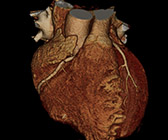Interventional Radiology Procedures
Interventional radiologists (IRs) use their expertise in reading X-rays, ultrasound and other medical images to guide small instruments such as catheters (tubes that measure just a few millimeters in diameter) through the blood vessels or other pathways to treat disease percutaneously (through the skin). These procedures are typically much less invasive and much less costly than traditional surgery.
Common Uses of Interventional Radiology
| Uterine Artery Embolization / Uterine Fibroid Embolization A procedure of uterine arteries to stop life- threatening postpartum bleeding, potentially preventing hysterectomy. The same procedure is used to treat fibroid tumors. |
| Varicose Vein Treatment An effective minimally invasive treatment of varicose veins with no scarring and minimal postoperative pain. |
| Vertebroplasty A non-surgical procedure for vertebral compression fractures, can help treat back pain safely and effectively. |
| Angiography An X-ray exam of the arteries and veins to diagnose blockages and other blood vessel problems. |
| Balloon Angioplasty Opens blocked or narrowed blood vessels by inserting a very small balloon into the vessel and inflating it. |
| Biliary Drainage and Stenting A stent to open up blocked ducts and allow bile to drain from the liver. |
| Central Venous Access Insertion of a tube to allow patients to receive medication or nutrients directly into the blood stream or so blood can be drawn. |
| Chemoembolization Delivery of cancer-fighting agents directly to the site of a tumor. |
| Embolization Delivery of clotting agents directly to an area that is bleeding or to block blood flow to an aneurysm or a fibroid tumor in the uterus. |
| Fallopian Tube Catheterization A treatment for infertility – uses a catheter to open blocked fallopian tubes without surgery. |
| Gastrostomy Tube Feeding tube inserted into the stomach for patients who are unable to take sufficient food by mouth. |
| Hemodialysis Access Maintenance Use of angioplasty or thrombolysis to open blocked grafts for hemodialysis. |
| Needle Biopsy Diagnostic test for breast, lung and other cancers; an alternative to surgical biopsy. |
| Radio frequency (RF) Ablation Use of radio frequency energy to cook and kill cancerous tumors. |
| Stent A small flexible tube used to treat a variety of medical conditions. |
| Stent-graft Reinforces a ruptured or ballooning section of an artery (an aneurysm) with a fabric-wrapped stent |
| Thrombolysis Dissolves blood clots by injecting clot-busting drugs at the site of the clot. |
| TIPS (transjugular intrahepatic portosystemic shunt) A procedure to improve blood flow and prevent hemorrhage. |
Web Link: For more comprehensive information, log on to the American College of Radiology and the Radiological Society of North America’s Patient Information website at www.radiologyinfo.org.
This page is intended as an educational resource only. It is not a substitute for professional care. Please see your physician if you have any concerns about your own health.



